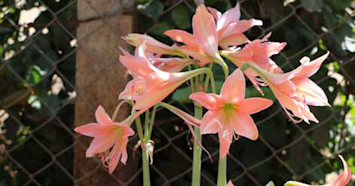
Plants are in most homes and provide a variety of benefits for your family. They even add to the decor. However, certain plants aren’t ideal around your furry family members. With such an extensive list of plants toxic to cats and dogs, it’s critical to know which ones you should keep out of reach of your pets, or better yet - pass on to someone else who doesn’t have animals.
Here are some specific plants you should keep out of your home/garden if you have pets and the symptoms you should be on the lookout for in case your pet gets into one of them, whether at home or somewhere else.
Toxic Plants for Pets & Symptoms After Exposure
1. African Wonder Tree
This plant has ricin, making it one of the most highly toxic house plants to dogs and cats. Ricin is a toxic compound, which inhibits protein synthesis. Although the entire plant is toxic, the beans are exceptionally dangerous as that’s where the ricin is.
Symptoms: Weakness, excessive thirst, loss of appetite, trembling, difficulty breathing, seizures, bloody diarrhea, colic, loss of coordination, and death.
2. Alocasia
This plant may also be called elephant’s ear. What makes this plant so toxic is the presence of insoluble calcium oxalates.
Symptoms: Swelling and pain of the mouth, excessive drooling, difficulty swallowing, vomiting, and oral irritation.
3. Aloe
Saponins and anthraquinones make this plant toxic. Aloe is a popular household plant, so if you must have it in a home with pets, keep it out of reach of your curious furry friends.
Symptoms: Lethargy, diarrhea, and vomiting
4. American Holly
Some other names you may know this plant by are English holly, inkberry, European holly, winterberry, and Oregon holly. This plant belongs to the aquifoliaceae family and is considered toxic due to saponins.
Symptoms: Depression, diarrhea, and vomiting
5. Apples, apricots, cherries, peaches, & plums
The danger with these fruits is cyanogenic glycosides in the seeds, pits, and leaves. Keep them out of your pet’s reach and always core them if you want to share them as a snack.
Symptoms: Dilated pupils, shock, panting, and difficulty breathing
6. Barbados Lily
Some additional names for this plant are fire lily, ridderstjerene, lily of the palace, and amaryllis. The Barbados Lily belongs to the Amaryllidaceae family and is toxic due to lycorine and other alkaloids.
Symptoms: Diarrhea, vomiting, low blood pressure, cardiac arrhythmias, tremors, convulsions with large ingestion, and salvation
7. Begonia
With over 1,000 species, it’s important that the household plant you choose isn’t part of the begoniaceae family. Because of the soluble calcium oxalates, this plant is toxic to both dogs and cats. The most toxic part of the plant is underground but you should still keep your pets away.
Symptoms: Salivation and vomiting
8. California Ivy
What makes this common household plant so toxic is the triterpenoid saponins. This plant is part of the Hedera helix family and it can go by other names such as sweetheart ivy, English ivy, needlepoint ivy, glacier ivy, and branching ivy.
Symptoms: Diarrhea, hypersalivation, abdominal pain, and vomiting
9. Nightshade
Also known as black nightshade or deadly nightshade, this plant is part of the solanaceae family. Solanine, atropine, and saponins make this plant toxic.
Symptoms: Reduced heart rate, dilated pupils, weakness, behavioral changes, confusion, drowsiness, diarrhea, severe gastrointestinal upset, inappetence, and hypersalivation.
10. Rhubarb
Also known as pie plant, rhubarb belongs to the polygonaceae family. Toxicity comes from the soluble calcium oxalates.
Symptoms: Salivation, tremors, and kidney failure
11. Sacred Bamboo
Cyanogenic glycosides make this plant toxic. The sacred bamboo is also known as nandina or heavenly bamboo and is part of the Berberidaceae family.
Symptoms: Respiratory failure, coma, seizures, incoordination, and weakness. Death is rare in pets.
12. Sago Palm
Part of the Cycadaceae family, Sago Palm is also known as cycads, zamias, cardboard palm, and coontie palm. The cycasin in the plant is what makes it toxic.
Symptoms: Liver failure, liver damage, coagulopathy, bruising, hemorrhagic gastroenteritis, increased thirst, icterus, melena, and vomiting
13. Tarragon
The toxicity in this plant comes from the essential oils. Other names for Tarragon include Estragon and French Tarragon.
Symptoms: Diarrhea and mild vomiting
14. Tomato Plant
This well-known plant is part of the solanaceae family and is toxic due to the solanine. It’s important to note that ripe fruit is non-toxic.
Symptoms: Slow heart rate, dilated pupils, weakness, depression, severe gastrointestinal upset, inappetence, and hypersalivation.
15. Wandering Jew
Wandering Jew can also be known as speedy Henry. This plant belongs to the commelinaceae family.
Symptoms: Dermatitis
What to Do if Your Pet Gets Into a Toxic Plant
Now that you know what plants to look out for, what happens if your cat or dog gets into toxic plants? First and foremost, get your pet away from the plant and check to see if they’re breathing and behaving normally. While some toxins may cause vomiting naturally, inducing vomiting in cats should only be performed by a veterinary professional after proper assessment. Call the Pet Poison Helpline (855-213-6680) or get in contact with a veterinarian for further instruction. Depending on the plant that poisoned your pet, you’ll want to begin at home treatment as soon as possible or get them into a veterinary hospital immediately.
No matter the situation, you’ll find comfort in knowing that full coverage pet insurance will cover your pet’s medical expenses in the event of accidental exposure to a toxic plant. Embrace offers unique coverage plans for dogs and cats that covers every unexpected accident and illness. Learn more about our pet insurance options and request a quote today to get started.